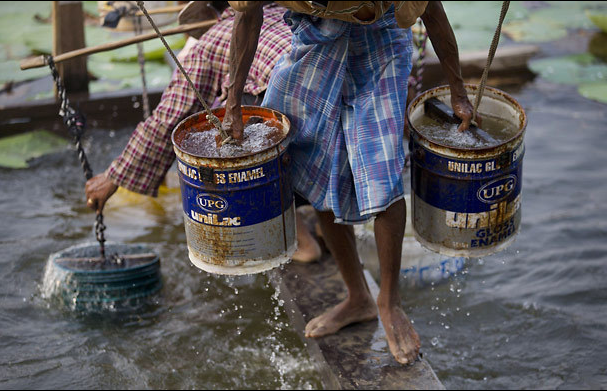Yes, I know, the quotation from Shakespeare’s Richard III concerns horses and not water, but then there was a time when horses were scarcer than water and at least arguably more important to survival. Those days are gone. And we didn’t need the most recent report from the UN’s Intergovernmental Panel on Climate Change to make the point or to underscore its importance. Such reports have been made over and again in recent years indicating that water shortages are accelerating throughout the world as patterns of industrial and agricultural usage are increasingly polluting both ground water and the water table, and consumption is outstripping renewable sources at progressively alarming rates. Nor is the problem one that is only taking place in underdeveloped regions or nations, as those living in California or West Texas can immediately and readily attest.
The photograph above is not from California or West Texas, but shows those living on the southern bank of the Yangon River in Myanmar using paint cans to collect drinking water during the annual dry season in which water shortages have led to the drying up of the reservoirs, forcing local elders to create rationing systems. And yet, while it is not California or West Texas it is not all that difficult to imagine how it could be in the altogether near future—or perhaps one of the other 34 states that the GAO anticipates will face water shortages in the near term. To get the point one needs to avoid focusing on the bare feet and rusted out paint cans that have been repurposed as water containers, let alone the brown skin, all of which underscore something other than a first world experience, and concentrate instead on how the photograph directs attention to the way(s) in which the need for water dominates everyday life in an otherwise visually indistinct location. There was a time when we would look at photographs of exotic locations and imagine that “their present is our past”; what we see here, however, is the way in which water is the great leveler that perhaps predicts that their present is our future.
The photograph did not receive much attention in the national media. I found it in a “pictures of the day” slide show at the Seattle Times nestled between images of a moving sculpture at a music festival in California and men warming themselves at a fire near the barricades at a Ukrainian security office proximate to the Russian border. As one more sluice of life incidentally contrasting the hardships of life “there” to the fun and festivities of life “here,” it would be altogether easy to miss, or merely to glance past without paying too much attention to it. Indeed, there was a time, not so long ago, when photographs of this sort would show up in places like National Geographic where readers would be encouraged to view the “present” of indigenous people in such exotic locations as “our past,” the assumption being that one day they too can experience the progress that modernity promises; here, however, it would seem that their present is cast as “our future.” Or more to the point, it is a future that is already present without our clear recognition of it.
What makes the photograph all the more poignant is not just the way in which it serves as a kind of foreboding prophecy, but more, as it functions as something of an allegory for how to imagine the very problem of water shortage itself. Note how the scene underscores the necessity of performing a careful balancing act, both socially and environmentally, to make the system of water recovery work. More to the point, note in particular not just how feet and hands strain so as to maintain equipoise on the balancing beam, but also how both participants need to coordinate with the other so as to avoid disrupting the overall ecology in which each operates. Whether or not we can actually adjust our contemporary patterns of resource usage and consumption so as to effect a sustainable world is open to question. But it will take effort and strain, and surely the appeal to “balance” that makes this system appear to work is more than worth the effort; indeed, it seems altogether necessary.
The bigger point, of course, is that solutions to such problems are right before us if we are willing to see them. And photographs such as this, however subtle or otherwise hidden within the visual landscape, can serve as a powerful optic to help us do just that. Look. See. Engage.
Credit: Gemunu Amarasinghe/AP

Discussion